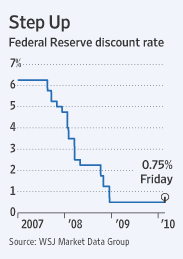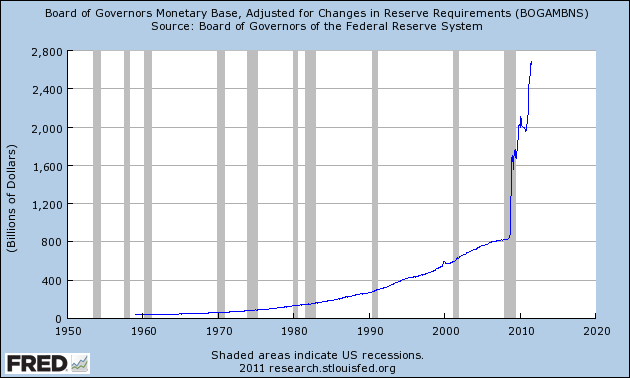Introduction
The 2007 financial crisis in the United States led into a decline in the level of liquidity within the economy. Thornton (2009, p.13) defines liquidity as the amount of credit available in the financial markets. Reduction in the level of liquidity can limit a country’s rate of economic growth. For example, one of the ways through which this can occur is by reducing the rate of public and private investments which is a key component in a country’s economic growth.
In its operation, as a government instituton, the Federal Reserve is charged with the responsibility of promoting economic growth. One of the ways through which Fed achieves this is by ensuring that there is enough money supply in the economy. Additionally, Fed is also charged with the responsibility of ensuring price stability and increasing the rate of employment.
During the 2007 economic crisis, there was an increment in the rate of unemployment in the US. This arose from a decline in the rate of investment. As a result, Fed was forced to intervene by increasing liquidity in order to prevent the economy from deteriorating further. The institution achieved this through integration of various aggressive strategies. The objective of this paper is to analyze the steps taken by the Federal Reserve from 2008 to increase liquidity.
Actions taken
Reduction in Federal funds target rate
In an effort to increase the credit available, the Federal Open Market Committee (FOMC) undertook an open market operation (The Federal Reserve Board, 2007, p. 1). For example, the borrowing rates were reduced by 75 basis points. This reduced Fed’s fund rate to 3.5%.
Through the open market operation, Fed’s fund rate was further reduced by 50 basis points. During subsequent meetings, FOMC reduced the federal funds rate further. For example in during the March 18 meeting, the rate was reduced to 2%. Despite this, liquidity did not improve. This prompted FOMC to reduce the federal funds rate to 0.25%.
Reduction in Fed’s fund rate has a direct impact on other interest rates such as the primary credit rate which refers to the rate at which financial institutions receive loans from fed for a short duration. The table below illustrates the reduction in the federal funds target rate and hence the primary credit rate from 2007 and 2008 and the subsequent reduction in the primary credit rate.
Discount window
This refers to the various credit facilities which are used by the Federal Reserve in an effort to regulate the amount of credit available in the economy. Discount window is used by Fed to alleviate liquidity problems in financial institutions. This aids in assuring liquidity within the economy.
As a result of the 2007 economic crisis, Fed reduced the discount window rate in an effort to encourage banks to borrow so as to increase credit availability. Prior to the occurrence of the economic crisis, Fed had set the discount rate at a point higher than fed’s fund rate. The objective was to limit borrowing by financial institutions. The chart below illustrates the reduction in Fed’s discount rate.

New lending programs
Despite the reduction in the discount window, most financial institutions were reluctant to borrow from Fed. As a result, Fed formulated alternative lending programs. One of these programs is the Term Auction Facility (TAF). The program entailed auctioning funds to deposit taking financial institutions.
It was Fed which determined the amount of funds to auction to the financial institutions. Additionally, financial institutions paid the ‘stop-out rate’ rather than the normal discount rates. According to Thornton (2009, p. 4), the ‘step-out rate’ entailed the lowest interest rate bid that Fed considered would be applicable in order to exhaust the amount of funds being auctioned.
Additionally, Fed also developed other programs which include the Primary Dealer Credit Facility (PDCF), Market Mutual Fund Facility (MMMF) and Asset Backed Commercial Paper (ABCP). The PDCF was aimed at reducing the discount rate applicable to primary government security holders.
On the other hand, ABCP and MMMF were aimed at increasing the level of liquidity in deposit taking financial institutions. For a number of years, Fed had managed to keep the monetary base at a low level. Integration of these new lending programs led into an increment in the monetary base in 2008 as illustrated in the chart below.

Asset Purchase Program
In an effort to enhance price stability and to promote the rate of employment, Fed developed a program that was aimed at purchasing assets. The program specifically targeted at purchasing long term securities. During the implementation of this program, Fed appreciated the fact that purchasing long term assets could result into an increase in money supply.
An increment in money supply can stimulate inflation if it is not controlled (Marthinsen, 2008, p. 47). In order to prevent this, Fed purchased the long term assets which are characterized by limited liquidity with financial assets with a high liquidity. One of the ways that fed used in making the payment entailed the use of mortgage backed securities (Board of Governors of the Federal Reserve System, 2011, p.1).
Conclusion
Incorporation of different tools enabled Fed to contain the 2007 economic crisis in the US. For example, by undertaking open market operation and reducing the discount rate, Fed was able to increase liquidity within the economy. This arose from the fact that money was made available in the economy. On the other hand, integration of new lending programs played a critical role in enhancing liquidity within the economy.
The asset purchasing program enabled Fed to maintain price stability and to increase the level of employment. As a result of these interventions, Fed was able to stimulate the US towards economic recovery. This illustrates that Fed was able to meet its objectives of improving the country’s economic outlook.
Despite Fed’s intervention, there is a high probability of the US economy experiencing another economic crisis due to a number of reasons. One of the factors that might limit the effectiveness of these interventions relate to the political challenges that the US is experiencing with regard to managing its debt ceiling.
Additionally, the country is also facing a relatively high rate of unemployment. Another challenge that may limit the country’s economic growth relates to the recent downgrading of the US government by Standard & Poors from the AAA grade. This might result into a decline in the rate of foreign direct investment. In order to eliminate these challenges, the US government should ensure that there is political stability within the economy. Additionally, the government should also formulate policies aimed at creating new jobs.
Reference List
Board of Governors of the Federal Reserve System. (2011). The Federal Reserve Asset Purchase Program. Web.
Federal Reserve Bank of St. Louis. (2011). Board of Governors Monetary Bas Adjusted for Changes in Reserve Requirements (BOGAMBNS). Web.
Hilsenrath, J. (2010). Rate rises stirs questions. New York: The Wall Street. Marthinsen, J. (2008). Managing in a global economy; demystifying international macroeconomics. Mason, OH: Thomson Publishers.
Taylor, J. (2008). The financial crisis and the policy responses: an empirical analysis of what went wrong. Web.
The Federal Reserve Board. (2007). Minutes of the federal open market committee. Web.
Thornton, D. (2009). The Fed, liquidity and credit allocation. Web.